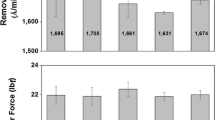Abstract
A polishing pad is an important component in a chemical mechanical polishing (CMP) system. Few investigations have specialized in the variation of the characteristics of the pad as it undergoes wear. All of the information concerning a pad, such as compressibility and pad life, comes from the manufacturer. No acknowledged standard or instrument exists for determining a pad’s quality. This study obtained the variation of the compressibility (K) of major types of pad (single-layer pad and composite pad) with polishing time (pad wearing) by theoretical modeling and real experiments. The K of single-layer or composite pads changes due to wear, and the trends in the K values of the two types of pads are exactly opposite. A finite element method (FEM) is used here to show that the variation in K strongly affects the polishing process. Theoretically, the compressibility of a pad can be used to judge whether the pad is good for polishing or not.
Similar content being viewed by others
References
Tso PL, Ho SY (2004) Study on the dressing rate of CMP pad conditioning. Key Eng Mat 257–258:377–271
Baker AR (1996) ECS 1996 Fall meeting, San Antonio, Texas, October 1996
Torquato S, Gibiansky LV, Silva MJ, Gibson LJ (1998) Effective mechanical and transport properties of cellular solids. Int J Mech Sci 40(1)::71–82
Zhu HX, Mills NJ (2000) The in-plane nonlinear compression of regular honeycombs. Int J Solids Struct 37(13):1931–1949
Sung J, Pai YL (2000) Advances in abrasive technology III. The Society of Grinding Engineers, Japan, p 189
van der Velden P (2000) Chemical mechanical polishing with fixed abrasives using different subpads to optimize wafer uniformity. Microelectron Eng 50(1–4):41–46
Preston FW (1927) The theory and design of plate glass polishing machines. J Soc Glass Tech 11:214–256
Acknowledgements
The authors would like to thank the National Science Council of the Republic of China for financially supporting this research under contract no. NSC-89-2212-E-007-013.
Author information
Authors and Affiliations
Corresponding author
Rights and permissions
About this article
Cite this article
Tso, PL., Hsu, R. Estimating chemical mechanical polishing pad wear with compressibility. Int J Adv Manuf Technol 32, 682–689 (2007). https://doi.org/10.1007/s00170-005-0386-1
Received:
Accepted:
Published:
Issue Date:
DOI: https://doi.org/10.1007/s00170-005-0386-1



